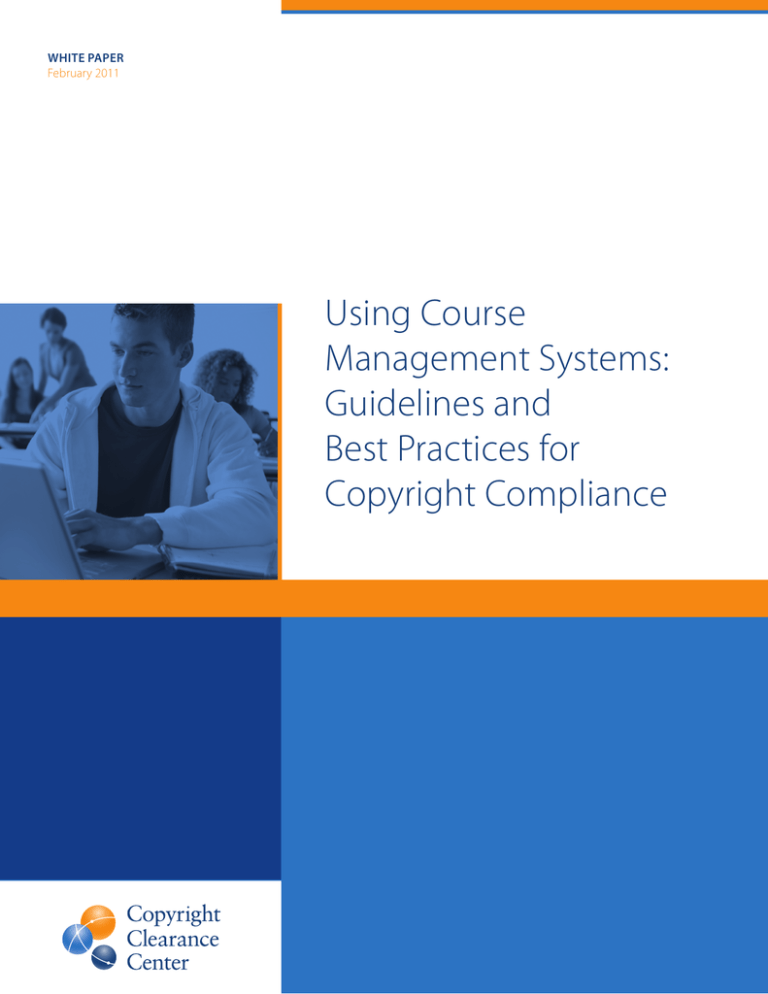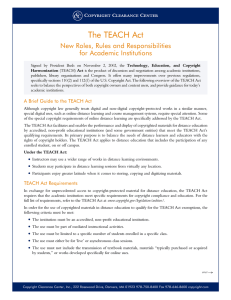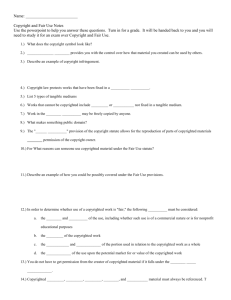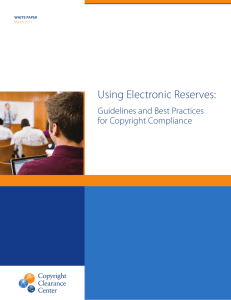
WHITE PAPER
February 2011
Using Course
Management Systems:
Guidelines and
Best Practices for
Copyright Compliance
WHITE PAPER
Using Course Management Systems:
Guidelines and Best Practices for
Copyright Compliance
The movement to course management systems
Industry experts estimate that more than 90% of U.S. colleges and universities use
course management systems.These systems are used to post and distribute tens of
thousands of copyrighted articles, book excerpts, charts and research data every year.
Although many institutions are working hard to address intellectual property issues
associated with such usage, copyright policy for course management systems remains
inconsistent across campuses and among individual users.
Best practices and guidelines for copyright and
course management systems
As course management systems and other technologies make copyrighted content
more easily accessible by faculty, staff members and other campus personnel,
establishing campus-wide policies for the lawful use of content is becoming increasingly
critical.The following principles summarize key guidelines and encapsulate examples
of best practices followed by many academic institutions regarding the posting and
management of copyrighted content in course management systems.
• Online doesn’t mean “free” – Widespread use of the Internet has fostered
misconceptions concerning the lawful use of copyrighted information in electronic
form. In short, the same copyright rules apply. Simply because content is placed
online in a course management system does not mean it is free from copyright
protection. Unless fair use or another exception applies, make sure you have
permission before posting content.
• Limit course materials to small excerpts – Most experts advise using a single
article or chapter, or less, of a copyrighted work, but even brief excerpts must be
viewed in the overall context of other readings offered for a course. If the total effect
is to create a compilation or “digital coursepack” of unlicensed materials, the case
for treating individual excerpts as fair use is significantly weakened and permission
should be sought.
01
WHITE PAPER
Using Course Management Systems:
Guidelines and Best Practices for
Copyright Compliance
• Course management system postings require the same permissions as
coursepacks – While there are obvious savings — financial and environmental — in
eliminating paper copies or coursepacks, traditional copyright rules still apply when
using digital technology such as course management systems:when fair use does
not apply, the institution must obtain permission from the rightsholder or its agent,
who may charge a fee for such permission based on the amount of content and the
number of people, usually students, who will view the content.
• Course management systems are not a substitute for the purchase of
coursepacks and textbooks – It violates the intent, spirit and letter of the law to use
course management systems as a substitute for the purchase of books, subscriptions
or other materials when substantial portions of the material are required for
educational purposes.
• Article links – Providing a link to the content in an online database subscribed to by
the institution’s library is allowed under copyright law provided the user is a current
member of the institution.
• Get permission before posting – You must secure copyright permissions prior to
posting content. Reposting of the same material for use in a subsequent semester
requires a new permission.
• Passwords are a good start – Restricting access to copyrighted content in course
management systems through passwords or other authentication measures is a
helpful, good-faith practice because rightsholders typically grant permission and
charge fees based on the number of students enrolled in a course. In fact, these
types of protections may make rightsholders more likely to grant permission, since
they provide a greater level of control than do paper coursepacks. Still, the use of
authentication measures, such as passwords by themselves, is not enough to satisfy
the fair use standard, and permission is still required prior to use of the content.
• Know what you’ve paid for – Reuse rights included in subscriptions vary greatly
by publisher. Be sure to check your license’s terms and conditions to determine if
the rightsholder has granted you permission to post the copyrighted work within a
course management system. This can alleviate the need to request permission and
ensure you don’t pay twice for rights you already hold.
• Work from authorized originals – When scanning in paper materials (such as
textbooks) to create electronic copies, be sure that you are working from legally
obtained original copies of the work, either purchased or owned by the institution.
• Remove expired course materials promptly – Make sure you take down
(or remove access to) copyrighted materials for a particular class when the
term concludes.
• Include copyright notices – Materials posted in a course management system
should contain both the copyright notice from, and a complete citation to, the
original material, as well as a clear caution against further electronic distribution.
02
WHITE PAPER
Using Course Management Systems:
Guidelines and Best Practices for
Copyright Compliance
The best way to secure copyright permission for your
course management systems
Copyright Clearance Center makes it easy to obtain permission to use copyrighted
content in course management systems. Our convenient online services enable
academic institutions—including librarians, faculty and staff, administrators, reprographic
services and campus bookstores—to obtain permission to use and to share information
with students, colleagues, alumni, the media and more.
For more
information,
please visit
copyright.com
Go to copyright.com for instant permission to use copyrighted content from tens of
thousands of works—including the leading titles in science, technology, medicine,
business and news—in course management systems, as well as e-reserves, interlibrary
loan, document delivery, print and electronic coursepacks, classroom handouts and
many other formats.
For more information about Copyright Clearance Center’s compliance solutions, please
e-mail us at info@copyright.com or call us at 978-750-8400.
03
WHITE PAPER
February 2011
Representing copyright holders from around the world, Copyright Clearance Center (CCC) is
a global rights broker for millions of the world’s most sought after content, including in- and
out-of-print books, e-books, journals, blogs, newspapers, magazines and images.
Started in 1978, CCC creates innovative licensing solutions that help businesses get
permission to use copyright-protected materials while compensating authors, publishers
and other content creators for the use of their works. CCC serves organizations of all types
and sizes, including 400 of the Fortune 500 companies, and licenses more than 20 million
content users in over 180 countries.
ACA0211
222 Rosewood Drive
Danvers, MA 01923 USA
+1.978.750.8400 Phone
+1.978.646.8600 Fax
info@copyright.com
www.copyright.com
© 2011 Copyright Clearance Center, Inc.
All rights reserved. Copyright Clearance Center and
the Copyright Clearance Center logo are registered
trademarks of Copyright Clearance Center, Inc.
About Copyright Clearance Center





